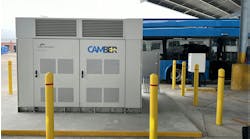WAVE inductive chargers to power Twin Transit Authority vehicles
Twin Transit Authority (TTA), which serves the Centralia and Chehalis, Wash., area, has completed its installation of WAVE’s 250-kw high-power wireless charging system to help the agency achieve its zero-emission goals.
WAVE's automated, cable-free system will be deployed in route to extend the range of TTA's first two battery-electric buses, representing a big leap forward in the agency's goal to make its entire 20 vehicle fleet carbon-neutral by 2030.
"Our organization sees this technology as a critical component of the future of electric bus operations, and we were determined to join forces with a company that was both easy to work with and had successful models of implementation" said TTA Executive Director Joe Clark. "WAVE's inductive charging was by far the most efficient and effective solution, and the easiest for our drivers to operate. Perhaps most importantly, WAVE was willing to be a strategic, long-term partner."
Within seconds of scheduled stops, the high power needed for meaningful range extension is transferred from ruggedized charging units embedded in the road surface to a receiving pad on the vehicle's undercarriage. Free from human contact and mechanical movement, a WAVE 250kW charger can add up to 25 miles of range to a 40-foot bus in just 10 minutes.
"With WAVE, we can augment our existing depot charging system by allowing our buses to bump charge throughout the day," continued Clark. "This allows us to extend the range of our fleet from about 150 miles to a virtually endless operating cycle. The WAVE model totally eliminates any charging range anxiety, while at the same time ensuring the efficient operation of our bus routes all day long."
WAVE says its technology has successfully undergone multiple rigorous commercial deployments throughout the country. Most notably, the Antelope Valley Transit Authority in Los Angeles County deployed 12 WAVE wireless chargers over 100 square miles, making it the largest mass transit deployment of wireless chargers in the world.
"The idea of purchasing multiple electric buses to cover the range of a single diesel bus can really hinder a transit agency's zero-emission plans," said WAVE CEO Mike Masquelier. “By making high-power range extension faster, easier and safer than legacy charging solutions, WAVE can enable a single electric bus to cover the longest of routes with minimal impact on normal operations. We look forward to expanding awareness of this game-changing new inductive charging platform and encouraging other transit agencies to follow Twin Transit's lead and help America reach its carbon zero goals."

